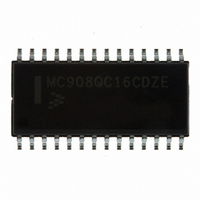MC908QC16CDZE Freescale Semiconductor, MC908QC16CDZE Datasheet - Page 87

MC908QC16CDZE
Manufacturer Part Number
MC908QC16CDZE
Description
IC MCU 8BIT 16K FLASH 28-SOIC
Manufacturer
Freescale Semiconductor
Series
HC08r
Specifications of MC908QC16CDZE
Core Processor
HC08
Core Size
8-Bit
Speed
8MHz
Connectivity
SCI, SPI
Peripherals
LVD, POR, PWM
Number Of I /o
24
Program Memory Size
16KB (16K x 8)
Program Memory Type
FLASH
Ram Size
512 x 8
Voltage - Supply (vcc/vdd)
3 V ~ 5.5 V
Data Converters
A/D 10x10b
Oscillator Type
Internal
Operating Temperature
-40°C ~ 85°C
Package / Case
28-SOIC (7.5mm Width)
Processor Series
HC08QC
Core
HC08
Data Bus Width
8 bit
Data Ram Size
512 B
Interface Type
ESCI/SPI
Maximum Clock Frequency
8 MHz
Number Of Programmable I/os
26
Number Of Timers
6
Maximum Operating Temperature
+ 85 C
Mounting Style
SMD/SMT
Development Tools By Supplier
FSICEBASE, M68CBL05AE, DEMO908QB8, DEMO908QC16
Minimum Operating Temperature
- 40 C
On-chip Adc
10-ch x 10-bit
For Use With
DEMO908QC16 - BOARD DEMO FOR MC908QC16
Lead Free Status / RoHS Status
Lead free / RoHS Compliant
Eeprom Size
-
Lead Free Status / Rohs Status
Lead free / RoHS Compliant
Available stocks
Company
Part Number
Manufacturer
Quantity
Price
Company:
Part Number:
MC908QC16CDZE
Manufacturer:
FREESCALE
Quantity:
1 600
Part Number:
MC908QC16CDZE
Manufacturer:
FREESCALE
Quantity:
20 000
8.3.1 Keyboard Operation
Writing to the KBIEx bits in the keyboard interrupt enable register (KBIER) independently enables or
disables each KBI pin. The polarity of the keyboard interrupt is controlled using the KBIPx bits in the
keyboard interrupt polarity register (KBIPR). Edge-only or edge and level sensitivity is controlled using
the MODEK bit in the keyboard status and control register (KBISCR).
Enabling a keyboard interrupt pin also enables its internal pullup or pulldown device based on the polarity
enabled. On falling edge or low level detection, a pullup device is configured. On rising edge or high level
detection, a pulldown device is configured.
The keyboard interrupt latch is set when one or more enabled keyboard interrupt inputs are asserted.
8.3.1.1 MODEK = 1
If the MODEK bit is set, the keyboard interrupt inputs are both edge and level sensitive. The KBIPx bit will
determine whether a edge sensitive pin detects rising or falling edges and on level sensitive pins whether
the pin detects low or high levels. With MODEK set, both of the following actions must occur to clear a
keyboard interrupt request:
The KBI vector fetch or software clear and the return of all enabled keyboard interrupt pins to a
deasserted level may occur in any order.
Reset clears the keyboard interrupt request and the MODEK bit, clearing the interrupt request even if a
keyboard interrupt input stays asserted.
8.3.1.2 MODEK = 0
If the MODEK bit is clear, the keyboard interrupt inputs are edge sensitive. The KBIPx bit will determine
whether an edge sensitive pin detects rising or falling edges. A KBI vector fetch or software clear
immediately clears the KBI latch.
Freescale Semiconductor
•
•
•
•
If the keyboard interrupt sensitivity is edge-only, for KBIPx = 0, a falling (for KBIPx = 1, a rising) edge
on a keyboard interrupt input does not latch an interrupt request if another enabled keyboard pin is
already asserted. To prevent losing an interrupt request on one input because another input remains
asserted, software can disable the latter input while it is asserted.
If the keyboard interrupt is edge and level sensitive, an interrupt request is present as long as any
enabled keyboard interrupt input is asserted.
Return of all enabled keyboard interrupt inputs to a deasserted level. As long as any enabled
keyboard interrupt pin is asserted, the keyboard interrupt remains active.
Vector fetch or software clear. A KBI vector fetch generates an interrupt acknowledge signal to clear
the KBI latch. Software generates the interrupt acknowledge signal by writing a 1 to ACKK in KBSCR.
The ACKK bit is useful in applications that poll the keyboard interrupt inputs and require software to
clear the KBI latch. Writing to ACKK prior to leaving an interrupt service routine can also prevent
spurious interrupts due to noise. Setting ACKK does not affect subsequent transitions on the
keyboard interrupt inputs. An edge detect that occurs after writing to ACKK latches another interrupt
request. If the keyboard interrupt mask bit, IMASKK, is clear, the CPU loads the program counter with
the KBI vector address.
MC68HC908QC16 • MC68HC908QC8 • MC68HC908QC4 Data Sheet, Rev. 5
Functional Description
87











